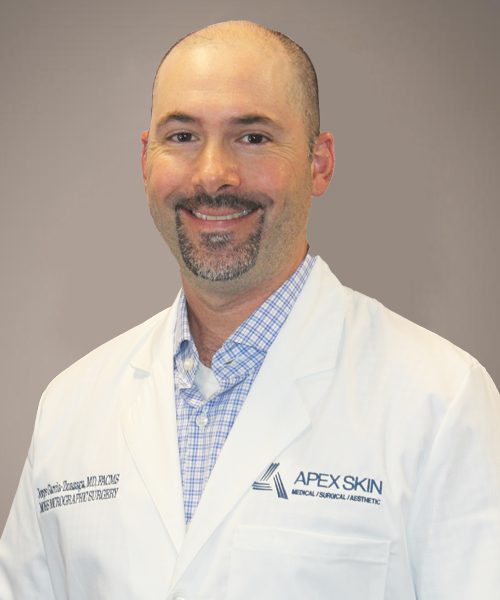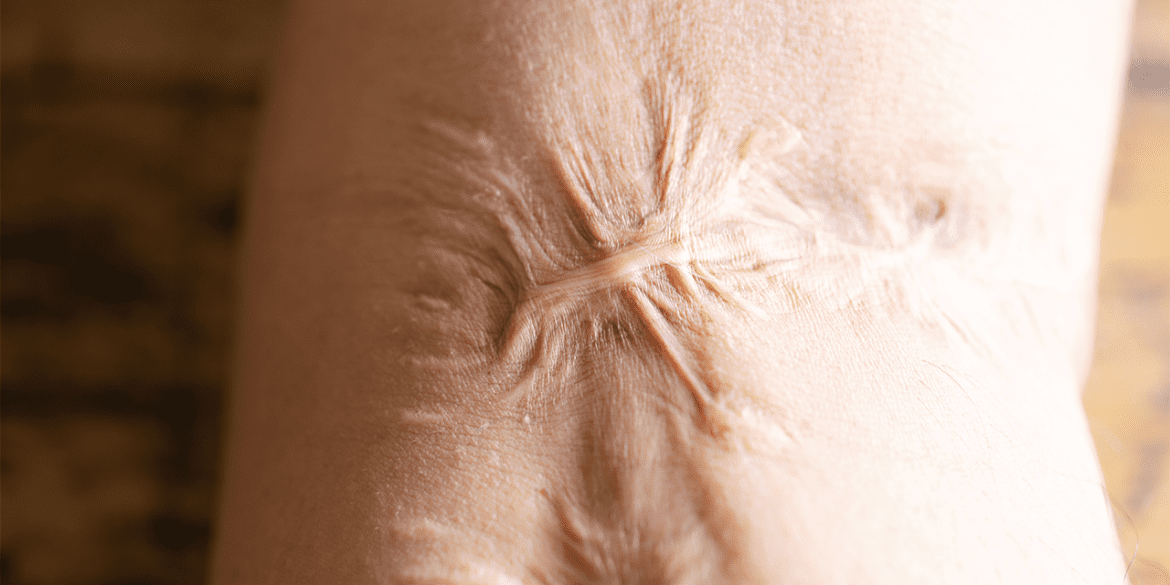No matter the cause, having scars can impact a person’s self esteem in many ways. It can be frustrating to deal with scarring whether caused by acne, scrapes, or other severe injuries.
Here to help us understand more about scarring, the types, and how to treat them is Apex Skin’s very own founder, Veteran, and Mohs skin cancer surgeon Dr. Jorge Garcia-Zuazaga.
What causes scarring?
In addition to being the largest organ in the body, the skin also functions as a protective barrier for the internal organs.
“In this defensive capacity, the skin is often subjected to harsh environmental elements, putting it at a heightened risk of sustaining injuries. When a wound or trauma to the skin takes place, the body’s natural response is the production of scar tissue.”
A scar is a fibrous tissue that contains high levels of collagen—the protein responsible for stimulating the production of new, healthy skin cells to repair the damage sustained from the injury. A visible scar forms when collagen levels at the wound site surpass the requirements of the damaged tissue.
We often see scarring with acne. Apex’s Acne Clinic provides a 360-degree approach to acne, including treatment of acne scarring.
In addition, as part of our commitment to our community, Apex’s Purple Heart Project offers complementary scar revision to qualified wounded veterans.
Do some people scar more easily than others?
Scars are visible signs that remain after a wound has healed. A scar will develop even if a wound heals without complications.
“Scarring is a natural part of our body’s healing process. There are some people that are predisposed to forming thicker scars based on genetics, immune status, medications, and other factors.”
Can scars hurt?
Scars may be a different texture or color than the surrounding healthy tissue making them more noticeable. Sometimes they itch, burn or hurt.
As the scar wound matures, it goes through phases. The scars can change colors (usually from more red to less red or pink). This is normal in scar formation.
Are there different types of scars?
Scars vary significantly in terms of location, size, and depth; however, all scars typically fall under one of four general categories:
Contractures: occur when a wound crosses a joint, or when there is a significant amount of tissue loss (as with a severe burn) and the skin and underlying tissue pull together during the healing process, causing the skin to contract and restricting movement in and around the area adjacent to the injury.
Hypertrophic Scars: often present as red, raised, and potentially painful clusters of scar tissue that form around the wound site. Hypertrophic scars may expand in width over time, and can be darker in color (hyperpigmented) or lighter in color (hypopigmented) than the patient’s healthy skin tone.
Discoloration and Surface Irregularities: scars in this category generally do not cause physical pain, nor do they have a detrimental impact on the body’s ability to function normally. Acne scars, as well as scars resulting from previous surgery or minor injury fall under this category and can be treated (depending on severity) and prevented through our Acne Clinic.
Keloid Scars: typically larger than hypertrophic scars, keloid scars often extend beyond the edges of the original wound, and have the potential to pucker, or to become itchy or painful.
How do you get rid of scars?
Scar revision treatment is largely determined by the type and degree of scarring.
Treatments may include topical treatments, minimally invasive procedures or surgical procedures using advanced wound closure techniques
Surface Treatments: these treatments function by minimizing uneven pigmentation and softening surface irregularities through the removal (exfoliation) of the outermost skin layers, or by altering the surface of the skin and promoting the growth of healthy skin cells at the wound site. Microneedling, microdermabrasion, skin bleaching agents, laser/light therapy, and chemical peels are examples of treatments in this category.
Injectable Treatments: steroidal-based compounds that are periodically injected at the wound site in order to reduce collagen build-up and improve the appearance of the raised scar tissue
Topical Treatments: best suited for very minor wounds, this category includes gels, tapes, or external compression to facilitate wound healing and closure. Silicone gels work well as first line agents for some scars.
Surgical Treatments: best suited for deeper scars and for scars that impair the patient’s mobility, surgical scar revision techniques may include pharmaceutical tissue substitutes, complex flap closure, or tissue expansion (used as an alternative to skin grafts).
Can scars be completely removed?
While scars cannot be completely removed, there are many tools dermatologists can use to lessen the appearance of scars.
If you have scarring, come visit one of our providers at Apex Dermatology! Same-day appointments are available!
About Dr. Garcia-Zuazaga
 Dr. Garcia-Zuazaga graduated from Marquette University with a degree of Biomedical Engineering. In college he earned a prestigious National Science Foundation scholarship and served as President of the Latin American Student Association. From Milwaukee, he moved to Ames, Iowa, where he completed his Master’s degree in Biomedical Engineering. It was his work with artificial heart valves that led him to consider a career in medicine.
Dr. Garcia-Zuazaga graduated from Marquette University with a degree of Biomedical Engineering. In college he earned a prestigious National Science Foundation scholarship and served as President of the Latin American Student Association. From Milwaukee, he moved to Ames, Iowa, where he completed his Master’s degree in Biomedical Engineering. It was his work with artificial heart valves that led him to consider a career in medicine.
In 1995, Garcia-Zuazaga was commissioned in the United States Navy and enrolled in the Navy Health Profession Scholarship Program. In 1999, he graduated at the top 5% of his medical school class at Penn State and moved to DC to complete his Internship at the renowned National Naval Medical Center in Bethesda, Maryland.
After Bethesda, Dr. Garcia-Zuazaga moved to Pensacola, Florida for Aerospace Medicine training with the Navy. He earned his “wings of gold” as a United States Flight Surgeon in 2001 and was the recipient of the prestigious Surgeon General’s Award. Following his training at the Naval Aerospace Medical Institute, Dr. Garcia-Zuazaga moved to the
Marine Corps Air Station, Beaufort, South Carolina where he was assigned as flight surgeon for the world famous Crusaders (VMFA-122) squadron. As flight surgeon he served as Medical Department head for his squadron and participated in several deployments all over the world. For his leadership and dedication to the Marines, Dr. Garcia was selected as Marines Forces Pacific (MARFORPAC) Operational Flight Surgeon of the Year.
Learn more about Dr. Garcia here.



